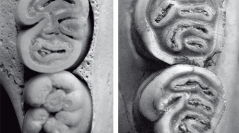

 Geodiversitas
33 (4) - Pages 729-738
Geodiversitas
33 (4) - Pages 729-738We evaluate the taxonomic affinities of an Hystricid from the Plio-Pleistocene hominid site of Uraha (Chiwondo Beds), northern Malawi. At the cross roads between eastern and southern Africa, these deposits are both unique and interesting because of their age (they encompass a period of major climatic change and have yielded early Homo remains). We describe here the third upper molar found in Uraha and compare it with Hystrix leakeyi Denys, 1987 and H. makapanensis Greenwood, 1958 specimens. The new specimen is smaller than H. makapanensis and H. leakeyi. It also differs from the fossil species by the absence of posteroloph and a smaller lingual sinus and oblique labial lophs. The new Hystrix Linnaeus, 1758 specimen has a small size and is bunodont, which differentiates it from the modern species found in Malawi today like H. cristata Linnaeus, 1758 and H. africaeaustralis Peters, 1852. It could belong either to a new species or enter into the variability of the described ones, but due to the low degree of knowledge of Hystrix molar morphology and variability as well as the very low number of specimens for comparison, we retain an indeterminate status for this specimen. Further, we ascribe the absence of small mammals and especially small rodents in these lake-shore deposits to taphonomic and palaeoecological phenomena.
Mammalia, Rodentia, Hystrix, Rift valley, Malawi lake, Taphonomy, Africa, Plio-Pleistocene, Hominid site